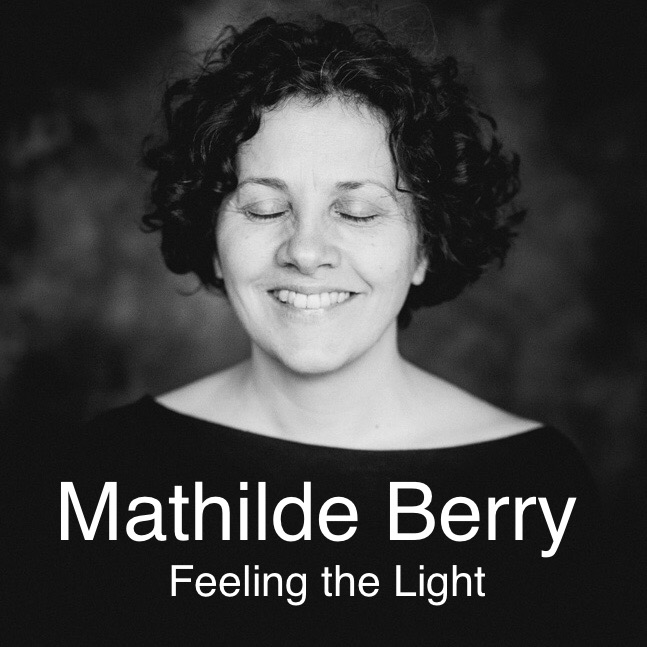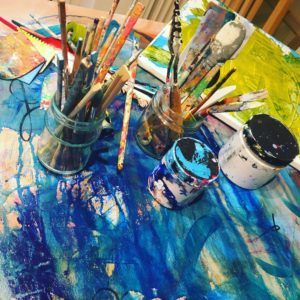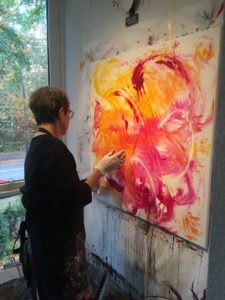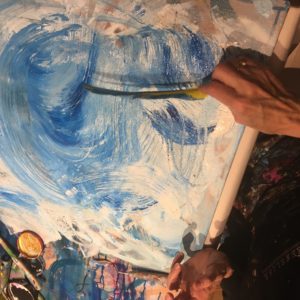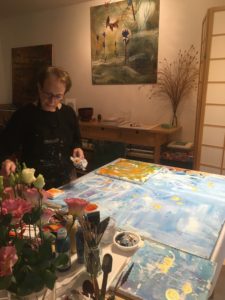One of the things that I love doing is to share my fascination for intuitive painting. Over the past three years, I’ve seen people around me pick up paint brushes and art supplies after trying themselves on a canvas in my atelier. So I’ve decided to start offering Saturday afternoon workshops in my atelier, for one, two or three people to discover the magical world of intuitive painting.
This blog post is for people curious about reuniting with their creativity
I’m delighted that Carol has kindly agreed to share her experience from last weekend. Here’s her account accompanied by the photographs that I took:
“I was fascinated by Mathilde’s art work after her first exhibition at Galerieka, so when she suggested that I should join her for a session in her atelier to learn about intuitive painting and see whether it might work for me, I decided to try. I had been going through a very emotional and unsettling period in my life and felt the need to focus on something new, positive and creative.
It was a total leap into the unknown for me: I was dismally bad at art when I was at school, trailing home with terrible report cards for the subject. I always felt totally overwhelmed by the rules and restrictions of drawing and perspective. I dabbled with water colours for a short while some years ago and enjoyed that – but personally would never, ever, dare to consider myself an artist. Mathilde soon put my fears to rest – you would have to search long and hard to find a more caring, patient and fun teacher.
She began by outlining the basic concept of intuitive painting – the idea that any one of us can liberate our inner ‘artist’ and creativity by setting free the childlike urge to express ourselves by means of colour. Paint is initially applied by using your hands – as well as the more traditional brushes, and other tools that are often everyday items that can help to embellish and form the structure of your painting. She showed me the basic materials required: blank canvases, paints (the so-called ‘warm’ and ‘cold’ colours) – with a colour chart showing complementary colours to these basics, brushes and a spray bottle for water (yes, you read that correctly).
Then I was ready to start, albeit slightly apprehensive: I was asked to choose two colours, and then advised by Mathilde to relax into the moment, listen to the music she had playing for us, close my eyes and hold out my hands – into which she squeezed the colours I had chosen. Still with my eyes closed, and relaxing into the music, I moved my hands over the canvas freely. I could not believe what a liberating sensation that was: I felt like a five-year-old again, experiencing the uncomplicated joy of putting paint onto a surface purely for fun. It was as if the years of restraint, of trying to be creative by sticking to the rules, had all melted away.
I was hooked from that moment on! A photograph of me when I opened my eyes and looked at the colour spread on the canvas, shows someone very relaxed and happy.
Together, Mathilde and I worked on canvases of different sizes, using different techniques and colours, different effects produced by using ‘tools’, squirting the canvas with water to release and drip the paint. You feel the paint, move it around, scrape it off, choose your colours and also decide you don’t quite like something. Not a problem: Mathilde’s doctrine is that there is no wrong way. You can always change what you have done if it doesn’t please you – opening up the possibility of experimenting as much as you like.
We painted together for several hours – the time flew by. I have proof of what I created on my canvases and I love the fact that I did. I cannot think of a better way to spend one’s time and I will certainly hope to paint with Mathilde again soon. I shall also be telling all my friends about this fascinating art form.
Thank you, Mathilde, for sharing your skill.”
Thank you, Carol, for trusting me as your guide in this process! Who else wants to give it a try? Let me know in the comments below or contact me by email on mathilde@mathildeberry.com or phone me on +49 160 96 20 30 40.
